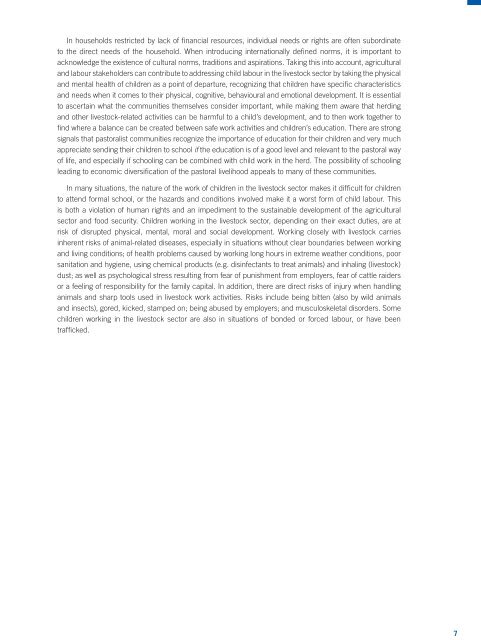Children’s work in the livestock sector: Herding and beyond
Children’s work in the livestock sector: Herding and beyond
Children’s work in the livestock sector: Herding and beyond
Create successful ePaper yourself
Turn your PDF publications into a flip-book with our unique Google optimized e-Paper software.
In households restricted by lack of f<strong>in</strong>ancial resources, <strong>in</strong>dividual needs or rights are often subord<strong>in</strong>ate<br />
to <strong>the</strong> direct needs of <strong>the</strong> household. When <strong>in</strong>troduc<strong>in</strong>g <strong>in</strong>ternationally def<strong>in</strong>ed norms, it is important to<br />
acknowledge <strong>the</strong> existence of cultural norms, traditions <strong>and</strong> aspirations. Tak<strong>in</strong>g this <strong>in</strong>to account, agricultural<br />
<strong>and</strong> labour stakeholders can contribute to address<strong>in</strong>g child labour <strong>in</strong> <strong>the</strong> <strong>livestock</strong> <strong>sector</strong> by tak<strong>in</strong>g <strong>the</strong> physical<br />
<strong>and</strong> mental health of children as a po<strong>in</strong>t of departure, recogniz<strong>in</strong>g that children have specific characteristics<br />
<strong>and</strong> needs when it comes to <strong>the</strong>ir physical, cognitive, behavioural <strong>and</strong> emotional development. It is essential<br />
to ascerta<strong>in</strong> what <strong>the</strong> communities <strong>the</strong>mselves consider important, while mak<strong>in</strong>g <strong>the</strong>m aware that herd<strong>in</strong>g<br />
<strong>and</strong> o<strong>the</strong>r <strong>livestock</strong>-related activities can be harmful to a child’s development, <strong>and</strong> to <strong>the</strong>n <strong>work</strong> toge<strong>the</strong>r to<br />
f<strong>in</strong>d where a balance can be created between safe <strong>work</strong> activities <strong>and</strong> children’s education. There are strong<br />
signals that pastoralist communities recognize <strong>the</strong> importance of education for <strong>the</strong>ir children <strong>and</strong> very much<br />
appreciate send<strong>in</strong>g <strong>the</strong>ir children to school if <strong>the</strong> education is of a good level <strong>and</strong> relevant to <strong>the</strong> pastoral way<br />
of life, <strong>and</strong> especially if school<strong>in</strong>g can be comb<strong>in</strong>ed with child <strong>work</strong> <strong>in</strong> <strong>the</strong> herd. The possibility of school<strong>in</strong>g<br />
lead<strong>in</strong>g to economic diversification of <strong>the</strong> pastoral livelihood appeals to many of <strong>the</strong>se communities.<br />
In many situations, <strong>the</strong> nature of <strong>the</strong> <strong>work</strong> of children <strong>in</strong> <strong>the</strong> <strong>livestock</strong> <strong>sector</strong> makes it difficult for children<br />
to attend formal school, or <strong>the</strong> hazards <strong>and</strong> conditions <strong>in</strong>volved make it a worst form of child labour. This<br />
is both a violation of human rights <strong>and</strong> an impediment to <strong>the</strong> susta<strong>in</strong>able development of <strong>the</strong> agricultural<br />
<strong>sector</strong> <strong>and</strong> food security. Children <strong>work</strong><strong>in</strong>g <strong>in</strong> <strong>the</strong> <strong>livestock</strong> <strong>sector</strong>, depend<strong>in</strong>g on <strong>the</strong>ir exact duties, are at<br />
risk of disrupted physical, mental, moral <strong>and</strong> social development. Work<strong>in</strong>g closely with <strong>livestock</strong> carries<br />
<strong>in</strong>herent risks of animal-related diseases, especially <strong>in</strong> situations without clear boundaries between <strong>work</strong><strong>in</strong>g<br />
<strong>and</strong> liv<strong>in</strong>g conditions; of health problems caused by <strong>work</strong><strong>in</strong>g long hours <strong>in</strong> extreme wea<strong>the</strong>r conditions, poor<br />
sanitation <strong>and</strong> hygiene, us<strong>in</strong>g chemical products (e.g. dis<strong>in</strong>fectants to treat animals) <strong>and</strong> <strong>in</strong>hal<strong>in</strong>g (<strong>livestock</strong>)<br />
dust; as well as psychological stress result<strong>in</strong>g from fear of punishment from employers, fear of cattle raiders<br />
or a feel<strong>in</strong>g of responsibility for <strong>the</strong> family capital. In addition, <strong>the</strong>re are direct risks of <strong>in</strong>jury when h<strong>and</strong>l<strong>in</strong>g<br />
animals <strong>and</strong> sharp tools used <strong>in</strong> <strong>livestock</strong> <strong>work</strong> activities. Risks <strong>in</strong>clude be<strong>in</strong>g bitten (also by wild animals<br />
<strong>and</strong> <strong>in</strong>sects), gored, kicked, stamped on; be<strong>in</strong>g abused by employers; <strong>and</strong> musculoskeletal disorders. Some<br />
children <strong>work</strong><strong>in</strong>g <strong>in</strong> <strong>the</strong> <strong>livestock</strong> <strong>sector</strong> are also <strong>in</strong> situations of bonded or forced labour, or have been<br />
trafficked.<br />
7


